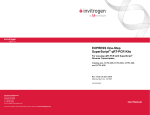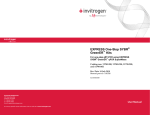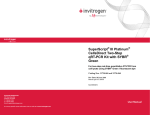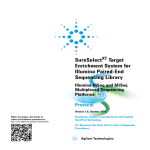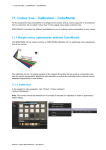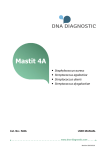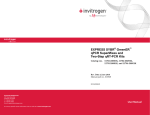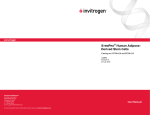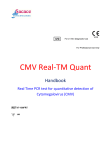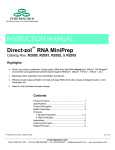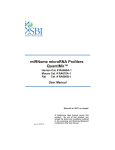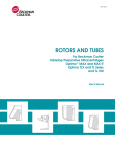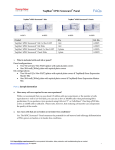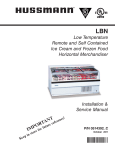Download SuperScript™ III Platinum® CellsDirect One-Step qRT
Transcript
CellsDirect™ One-Step qRTPCR Kits For one-step real-time quantitative RT-PCR from cell lysate Catalog Nos. 11753-100, 11753-500, 11754-100, 11754-500 Rev. Date: 25 May 2011 Manual part no. 25-0870 MAN0000536 Corporate Headquarters 5791 Van Allen Way Carlsbad, CA 92008 T: 1 760 603 7200 F: 1 760 602 6500 E: [email protected] For country-specific contact information visit our web site at www.invitrogen.com User Manual ii Table of Contents Kit Contents and Storage ...............................................................................................................v Additional Products.......................................................................................................................vi Introduction...................................................................................................................................... 1 Methods................................................................................................................ 3 General Guidelines for Lysing Cells ............................................................................................ 3 Lysing Larger Volumes of Cells.................................................................................................... 4 Lysing Cells in Tissue-Culture Wells ........................................................................................... 7 Lysing Cells Obtained by LCM..................................................................................................... 9 DNase I Digestion (Optional)...................................................................................................... 12 Guidelines and Recommendations—One-Step qRT-PCR ...................................................... 13 Cycling Programs—One-Step qRT-PCR ................................................................................... 17 One-Step qRT-PCR with Optional ROX .................................................................................... 18 One-Step qRT-PCR with ROX in the 2X Reaction Mix ........................................................... 21 Appendix ............................................................................................................ 24 Troubleshooting............................................................................................................................. 24 Purchaser Notification.................................................................................................................. 27 Technical Service ........................................................................................................................... 29 References ....................................................................................................................................... 31 iii iv Kit Contents and Storage Shipping and Storage Kit components are shipped on dry ice and should be stored at -20°C. Stability can be extended by storing components at -80°C. Note the following special storage conditions: Catalog nos. 11753-100 and 11753-500: Store tube of ROX Reference dye at -20°C in the dark. Catalog nos. 11754-100 and 11754-500: Store the 2X Reaction Mix containing ROX Reference dye at -20°C in the dark. Kit Components— Catalog nos. 11753-100 and 11753-500 Catalog nos. 11753-100 and 11753-500 contain a separate tube of ROX Reference Dye. Kit Size Component 100 rxns 500 rxns Resuspension Buffer 10 ml 10 ml Lysis Enhancer 1 ml 1 ml DNase I, Amplification Grade (1 U/μl) 500 μl 2 × 1.25 ml 10X DNase I Buffer 160 μl 800 μl 25 mM EDTA 400 μl 2 × 1 ml SuperScript® III RT/Platinum® Taq Mix 100 μl 500 μl (with RNaseOUT™ Ribonuclease Inhibitor) 2X Reaction Mix 2 × 1.25 ml 12.5 ml 1 ml 1 ml 50 mM MgSO4 DEPC-treated water 2 ml 12.5 ml HeLa Total RNA (10 ng/μl) 10 μl 10 μl ROX Reference Dye 100 μl 500 μl Kit Components— Catalog nos. 11754-100 and 11754-500 Catalog nos. 11754-100 and 11754-500 contain ROX Reference Dye in the 2X Reaction Mix. Kit Size 100 rxns 500 rxns Component Resuspension Buffer 10 ml 10 ml Lysis Enhancer 1 ml 1 ml DNase I, Amplification Grade (1 U/μl) 500 μl 2 × 1.25 ml 10X DNase I Buffer 160 μl 800 μl 25 mM EDTA 400 μl 2 × 1 ml SuperScript® III RT/Platinum® Taq Mix (with RNaseOUT™ Ribonuclease Inhibitor) 100 μl 500 μl 2X Reaction Mix with ROX 2 × 1.25 ml 12.5 ml 50 mM MgSO4 1 ml 1 ml DEPC-treated water 2 ml 12.5 ml HeLa Total RNA (10 ng/μl) 10 μl 10 μl Continued on next page v Additional Products Product Size Catalog No. LUX™ Custom Primers To order, visit www.invitrogen.com CellsDirect™ Two-Step qRT-PCR Kit 100 rxns 500 rxns 11737-030 11737-038 CellsDirect™ SYBR® Green Two-Step qRT-PCR Kit 100 rxns 500 rxns 11738-060 11738-068 CellsDirect™ cDNA Synthesis System 25 rxns 100 rxns 18080-200 18080-300 CellsDirect™ Resuspension and Lysis Buffer 10 ml Resuspension Buffer and 1 ml Lysis Enhancer 11739-010 Platinum® Taq DNA Polymerase 100 rxns 250 rxns 500 rxns 10966-018 10966-020 10966-034 vi Introduction System Overview The CellsDirect™ One-Step qRT-PCR Kit is an optimized kit for the detection and quantification of RNA or DNA directly from mammalian cell lysate, without a separate purification step. In traditional real-time quantitative RT-PCR (qRT-PCR), you first isolate RNA from cells in a time-consuming procedure that can lead to loss of material. Using the CellsDirect™ OneStep qRT-PCR Kit, you lyse the cells and add the complete lysate directly to a one-step qRT-PCR reaction with minimal handling and sample loss. You can add DNase I to the lysate as an optional step, to eliminate genomic DNA prior to qRT-PCR. Alternatively, you can analyze genomic DNA targets by omitting the DNase I step and using qPCR primers designed for your genomic sequence of interest. The CellsDirect™ One-Step qRT-PCR Kit has been optimized for small cell samples, ranging from 10,000 cells down to a single cell. This kit is compatible with fluorogenic primer technology such as LUX™ Primers or fluorogenic probe-based technology such as TaqMan® probes. The kit is also compatible with high-throughput applications and frozen samples obtained by Laser Capture Microdissection (LCM). Advantages of the Kit This kit offers the following advantages: • Eliminates time-consuming purification procedures that contribute to sample loss and PCR inhibition • Compatible with a wide range of mammalian cell types grown under different treatment conditions • Total lysate volume may be used (depending on the capacity of your real-time instrument), increasing sensitivity and allowing for detection of rare transcripts • Convenient one-step enzyme mix includes both SuperScript® III Reverse Transcriptase and Platinum® Taq DNA Polymerase Compatible with high-throughput applications and frozen samples obtained by LCM Can also be used to detect genomic DNA targets • • Continued on next page 1 Introduction, continued SuperScript® III RT SuperScript® III Reverse Transcriptase (RT) is an engineered version of M-MLV RT with reduced RNase H activity and increased thermal stability (Gerard et al., 1986; Kotewicz et al., 1985). The enzyme can synthesize cDNA at a temperature range of 42-60°C, providing increased specificity, higher yields of cDNA, and more full-length product than other reverse transcriptases. Because SuperScript® III RT is not inhibited significantly by ribosomal and transfer RNA, it can effectively synthesize cDNA directly from total RNA. Platinum® Taq DNA Polymerase Platinum® Taq DNA is a recombinant Taq DNA polymerase complexed with a proprietary antibody that inhibits polymerase activity at ambient temperatures (Chou et al., 1992; Sharkey et al., 1994; Westfall et al., 1997). Full polymerase activity is restored after the denaturation step in PCR, providing an automatic “hot start” for increased amplification efficiency, sensitivity, and yield. Control RNA HeLa Total RNA is included in the kit for use as a positive control. The concentration of HeLa Total RNA provided (10 ng/μl) is equivalent to 1,000 cells. 2 Methods General Guidelines for Lysing Cells Introduction This section provides general guidelines for lysing cells. You may perform an optional DNase I digestion to remove genomic DNA from the lysate prior to qRT-PCR (see page 12). However, if your gene-specific primers are well-designed (i.e., spanning an exon-intron-exon junction to avoid amplifying genomic DNA), you may skip this step for convenience. Alternatively, you may use this kit to detect genomic DNA targets in the lysate (omitting DNase I digestion). Cell Types and Density The SuperScript® One-Step qRT-PCR Kit has been optimized for small cell samples, ranging from 1 to 10,000 cells. This kit is compatible with several different mammalian cell lines, including HeLa, COS-7, 293, Jurkat, CV1, and primary cells, including stem cells and neural cells. Cells may be grown under a variety of conditions and treatments, and any type of culture vessel can be used. This kit is not intended for whole blood or macrophages. • Important • We recommend using a maximum of 10,000 cells per reaction. Higher numbers of cells may inhibit one-step qRT-PCR and result in reduced yields and/or truncated product. Make sure that all solutions and equipment that come in contact with the cells are sterile. Always use proper sterile technique and work in a laminar flow hood when handling cells. 3 Lysing Larger Volumes of Cells Introduction This section provides a protocol for lysing larger volumes of cells—i.e., cells in larger plates and flasks. For smaller samples in tissue-culture wells, see Lysing Cells in TissueCulture Wells, starting on page 7. Required Materials The following materials are provided by the user: • Mammalian cell cultures in growth medium • Coulter Counter or hemacytometer • Centrifuge (for pelleting cells) • Incubator or thermal cycler preheated to 75°C • Trypsin (for adherent cultures) • 1X cold phosphate-buffered saline (PBS), without calcium or magnesium • 0.2-ml thin-walled PCR tubes or PCR plates • Ice • Pipettes The following materials are provided in the kit: • Resuspension Buffer • Lysis Enhancer • MgSO4, 50 mM (optional) All steps should be performed on ice, and reagents should be chilled and/or thawed immediately prior to use. The incubator should be preheated to 75°C. Continued on next page 4 Lysing Larger Volumes of Cells, continued Lysis Procedure For adherent cell cultures, follow all the steps below. For cells in suspension, skip Steps 1–5 and proceed to Step 6 below. 1. Aspirate the media in each dish and wash each dish with an appropriate volume of 1X cold PBS (e.g., for a 10-cm dish or a T75 flask, use 10 ml PBS). Aspirate the PBS. 2. Add enough trypsin to cover the adherent cells in your tissue culture dish, plate, or flask (e.g., for a 10-cm dish, use ∼1 ml; for a T75 flask, use ∼3 ml). 3. Incubate for 5 minutes on ice or at room temperature. 4. Check for cell detachment under a microscope. If cells have not detached, gently tap the disk or flask to dislodge the cells, or let the cells incubate longer, checking them every minute under a microscope. 5. When all the cells have detached, add serum-containing medium to a final volume equaling the volume of PBS used in the Step 1 (for 6- and 12-well plates, add a 1X–2X volume of medium). Note that the medium must contain serum to inactivate the trypsin. 6. Pipet the cells gently up and down to mix, and then transfer the cell suspension to a centrifuge tube. 7. Spin the cells at 200 × g for 5 minutes to pellet (or spin at the recommended speed and time appropriate for your cell line). 8. Aspirate the medium and wash the cell pellet with 5– 10 ml of 1X cold PBS. 9. Spin the cells at 200 × g for 5 minutes to pellet. 10. Aspirate the PBS and resuspend the pellet in 500 μl to 1 ml of 1X cold PBS. Mix the cell solution gently. Protocol continued on next page Continued on next page 5 Lysing Larger Volumes of Cells, continued Lysis Procedure, continued Protocol continued from previous page 11. Collect a small aliquot (~10 μl) to verify that the cells are at the desired concentration. Determine cell density electronically using a Coulter Counter or manually using a hemacytometer chamber. 12. The cell density should be <10,000 cells/μl. If necessary, adjust the density using cold PBS. Count the cells again to verify cell concentration. 13. To a 0.2-ml thin-walled PCR tube or plate well on ice, add 1 μl of Lysis Enhancer and 10 μl of Resuspension Buffer. Note: A Master Mix of Lysis Solution (Lysis Enhancer and Resuspension Buffer) may be prepared for multiple reactions. 14. Transfer 1–2 μl of cells (<10,000 cells) to the PCR tube/well and cap or seal. Vortex briefly and spin down the contents. Note: This mixture may be frozen and stored at –80ºC until use. Thaw on ice before proceeding to the next step. 15. Transfer the tube/plate to an incubator, water bath, or thermal cycler that has been preheated to 75ºC and incubate for 10 minutes. 16. After incubation, spin the tube or plate briefly to collect any condensation. 17. Proceed to DNase I Digestion (Optional), page 12 or If you do not perform the optional DNase I digestion, adjust the Mg2+ concentration by adding 1 μl of 50-mM MgSO4 to each tube/well. Then proceed to One-Step qRT-PCR Guidelines and Recommendations, page 13. 6 Lysing Cells in Tissue-Culture Wells Introduction This section provides a protocol for lysing cells directly in tissue-culture wells (e.g., in 6-well to 384-well plates). For cells in larger vessels, see Lysing Larger Volumes of Cells, page 4. Cell Seeding Density For adherent cells grown in tissue-culture wells, seed cells so that 10 μl of resuspended cells will yield the desired concentration. Required Materials The following materials are provided by the user: • • • • • • • Mammalian cell cultures in growth medium Centrifuge (for pelleting cells) Incubator or thermal cycler preheated to 75°C 1X cold phosphate-buffered saline (PBS), without calcium or magnesium 0.2-ml thin-walled PCR tubes or PCR plates Ice Pipettes The following materials are provided in the kit: • • • Preparing Master Mix of Lysis Solution Tissue Culture Plate 6 well Resuspension Buffer Lysis Enhancer MgSO4, 50 mM (optional) For multiple reactions, prepare a Master Mix of Lysis Solution (Resuspension Buffer: Lysis Enhancer in a ratio of 10:1). See the chart below for the minimum volume of Lysis Solution required to cover the cells in each type of tissueculture well. Larger volumes may be used, if desired. Volume per Well Resuspension Buffer Lysis Enhancer 400 μl 40 μl Total 440 μl 12 well 200 μl 20 μl 220 μl 24 well 100 μl 10 μl 110 μl 48 well 50 μl 5 μl 55 μl 96 well 20 μl 2 μl 22 μl 384 well 10 μl 1 μl 11 μl Continued on next page 7 Lysing Cells in Tissue-Culture Wells, Continued Important Direct Lysis of Cells in TissueCulture Wells If you are processing many samples, additional Resuspension Buffer and Lysis Enhancer may be required. You can order additional CellsDirect Resuspension Buffer and Lysis Enhancer from Invitrogen (see page vi). For adherent cells grown in tissue-culture wells, perform the following lysis procedure. 1. Aspirate the medium in each well and wash each well with 1X cold PBS without magnesium/calcium. Aspirate the PBS. 2. Add the Lysis Solution master mix (see table on previous page) to each well. The master mix should cover the cells in the well. 3. Incubate the plates on ice for up to 10 minutes. During that period, tap the plate periodically and check the cells under a microscope every 2–3 minutes to see whether they have detached or burst. 4. After 10 minutes, gently pipet the cells up and down to dislodge the remaining attached cells. 5. Transfer 10 μl of the cell suspension to a 0.2-ml thinwalled PCR tube or plate well. 6. Cap or seal the tube/plate and transfer to an incubator or thermal cycler that has been preheated to 75°C. Incubate for 10 minutes. 7. After incubation, spin the tube or plate briefly to collect any condensation. 8. Proceed to DNase I Digestion (Optional), page 12 or If you do not perform the optional DNase I digestion, adjust the Mg2+ concentration by adding 1 μl of 50-mM MgSO4 to each tube/well. Then proceed to One-Step qRT-PCR Guidelines and Recommendations, page 13. Continued on next page 8 Lysing Cells Obtained by LCM Introduction This section provides a protocol for lysing cells from frozen samples obtained by LCM. LCM Using Arcturus CapSure® Caps The protocols in this section assume that you are using frozen LCM samples collected on Arcturus CapSure® caps. Two alternate lysis methods are described: the cap method or the polymer peel method (Gallup et al., 2005). Required Materials The following materials are provided by the user: • Mammalian cells obtained via LCM and immobilized on polymer film lining an Arcturus CapSure® cap • Centrifuge (for pelleting cells) • Heat block preheated to 75°C (for the cap method) • 1.7-ml Eppendorf microcentrifuge tube (for the cap method) • Thermal cycler or incubator preheated to 50°C and 75°C (for the polymer peel method) • RNase- and DNase-free forceps (for the polymer peel method) • 0.2-ml thin-walled PCR tubes • Pipettes The following materials are provided in the kit: • Resuspension Buffer • Lysis Enhancer • MgSO4, 50 mM (optional) For collection of very small samples using LCM (i.e., 100 cells or less), glycogen is commonly suggested. This kit is compatible with samples collected with glycogen. Continued on next page 9 Lysing Cells Obtained by LCM, continued Cap Lysis Method The following method lyses cells obtained by LCM directly on the Arcturus CapSure® cap. 1. For a single reaction, prepare 11 μl of Lysis Solution by adding 1 μl of Lysis Enhancer to 10 μl of Resuspension Buffer. Note: A Master Mix may be prepared for multiple reactions. 2. Invert the Arcturus CapSure® cap and carefully pipet 11 μl of Lysis Solution onto the immobilized cells. Be careful to place the drop directly on the sample; surface tension should keep this volume as a drop over the sample. 3. Carefully fit a microcentrifuge tube upside-down onto the cap. Be careful not to disturb the surface tension of the Lysis Solution over the cell sample. 4. With the tube still inverted on the cap, place the cap-andtube assembly directly on a heat block pre-heated to 75°C and incubate for 15 minutes. 5. After incubation, vortex the inverted cap-and-tube assembly briefly and then turn the tube right-side up and spin down briefly to collect the contents to the bottom of the tube. Discard the cap. 6. Proceed to DNase I Digestion (Optional), page 12 or If you do not perform the optional DNase I digestion, adjust the Mg2+ concentration by adding 1 μl of 50-mM MgSO4 to the tube. Then proceed to One-Step qRT-PCR Guidelines and Recommendations, page 13. Continued on next page 10 Lysing Cells Obtained by LCM, continued Polymer Peel Lysis Method The following method involves peeling off the polymer film with the attached cells from the Arcturus CapSure® cap and then lysing the cells in a tube. 1. Using clean forceps that are RNase and DNase-free, carefully peel off the polymer film “sticker” with the attached cells from the cap. 2. Place the polymer film at the bottom of a 0.2-ml thinwalled PCR tube and add 10 μl of Resuspension Buffer and 1 μl of Lysis Enhancer (a Master Mix may be prepared for multiple reactions). 3. Incubate the tube in a thermal cycler or incubator at 50°C for 10 minutes. 4. Vortex the tube and spin down briefly to collect the polymer and other debris at the bottom of the tube. 5. Transfer the aqueous solution to a new 0.2-ml thinwalled PCR tube. 6. Cap the tube and incubate in a thermal cycler preheated to 75°C for 5 minutes. 7. After incubation, spin the tube briefly to collect any condensation. 8. Proceed to DNase I Digestion (Optional), page 12 or If you do not perform the optional DNase I digestion, adjust the Mg2+ concentration by adding 1 μl of 50-mM MgSO4 to the tube. Then proceed to One-Step qRT-PCR Guidelines and Recommendations, page 13. 11 DNase I Digestion (Optional) Introduction In this optional step, you treat the cell lysate with DNase I to degrade the genomic DNA. Materials Needed The following materials are provided in the kit: DNase I Digestion • 10X DNase I Buffer • DNase I, Amplification Grade • 25 mM EDTA 1. To each tube/plate well, add the following components on ice: Component Amount per sample DNase I, Amplification Grade (1 U/μl) 10X DNase I Buffer 12 5 μl 1.6 μl 2. Mix by gently pipetting up and down or briefly vortexing, and spin briefly to collect the contents. 3. Incubate the tube/plate at 25°C (or room temperature) for 5 minutes. Note: A longer incubation time (up to 10 minutes) may be used for larger samples (>5,000 cells). However, incubation times exceeding 10 minutes can greatly reduce yield. 4. Spin briefly, and add 4 μl of 25 mM EDTA to each tube/plate well on ice. Mix by gently pipetting up and down, and spin briefly to collect the contents. 5. Incubate at 70°C for 10 minutes. 6. Spin briefly and place the tube or plate on ice before proceeding to the next section. Guidelines and Recommendations—One-Step qRT-PCR Introduction Important This section provides guidelines for setting up your one-step qRT-PCR reaction. Since PCR is a powerful technique capable of amplifying trace amounts of DNA, all appropriate precautions should be taken to avoid cross-contamination. Amount of Starting Material The amount of lysate you can use in the qRT-PCR reaction depends on your real-time instrument and the total reaction volume it can accommodate. For a 50-μl total reaction volume, up to 20 μl of lysate may be used. For a 20-μl total reaction volume, up to 10 μl of lysate may be used. Instrument Compatibility Catalog nos. 11753-100 and 11753-500: These kits can be used with a variety of real-time instruments, including but not limited to the ABI PRISM® 7000, 7700, and 7900HT; the ABI 7300 and 7500 Real-Time PCR Systems; the ABI GeneAmp® 5700; the Bio-Rad iCycler™; the Stratagene Mx3000P®, Mx3005P™, and Mx4000®; the Corbett Research Rotor-Gene™; the MJ Research DNA Engine Opticon™, Opticon® 2, and Chromo 4™ Real-Time Detector; and the Cepheid Smart Cycler®. Optimal cycling conditions will vary with different instruments. Catalog nos. 11754-100 and 11754-500: These kits include ROX Reference Dye in the 2X Reaction Mix at a final concentration of 500 nM. This concentration is compatible with the ABI PRISM® 7000, 7700, and 7900HT; the ABI 7300 Real-Time PCR System; and the ABI GeneAmp® 5700. These kits are not compatible with instruments that do not use ROX, or instruments that use ROX at a final concentration lower than 500 nM (e.g., the ABI 7500 and the Stratagene Mx3000P®, Mx3005P™, and Mx4000®). Continued on next page 13 Guidelines and Recommendations—One-Step qRT-PCR, continued Primers Gene-specific primers are required for one-step qRT-PCR. LUX™ Fluorogenic Primers are available separately from Invitrogen; see below for more information. A final concentration of 200 nM per primer is effective for most reactions. Doubling the amount of reverse primer (to 400 nM) may improve performance of certain reactions. Optimal results may require a primer titration between 100 and 500 nM. Detection Methods LUX™ Fluorogenic Primers LUX™ Primers are fluorogenic primers for qRT-PCR. Each LUX™ Primer set includes one primer labeled with single fluorophore and one corresponding unlabeled primer. The labeled primer is designed with a hairpin structure that provides built-in fluorescence quenching. When the primer is incorporated into double-stranded PCR product and extended, fluorescence increases by up to 10-fold. For more information, visit www.invitrogen.com/lux. To design LUX™ Primers for specific targets, visit www.invitrogen.com/dluxdesigner. Predesigned and functionally validated Certified LUX™ Primer Sets are also available. Dual-Labeled Probes Fluorescent dual-labeled probe technology such as TaqMan® probes requires two gene-specific primers as well as a probe that hybridizes to the internal portion of the amplicon. The probe sequence should be free of secondary structure and should not hybridize to itself or to primer 3´ ends. The optimal concentration of probe may vary between 50 and 500 nM, with a recommended starting concentration of 100 nM. Fluorescent Dyes This kit has been developed and optimized for use with fluorogenic primer or probe-based qPCR detection technology. For a CellsDirect™ kit with fluorescent binding dye technology, we recommend the CellsDirect™ SYBR® Green Two-Step qRT-PCR Kit (see page vi for ordering information). Continued on next page 14 Guidelines and Recommendations—One-Step qRT-PCR, continued Detecting Genomic DNA To detect genomic DNA targets in the lysate, use primers specific for your targets in the one-step reaction, and omit the 50°C cDNA synthesis step in the cycling program. SuperScript® III RT in the enzyme mix will be denatured during the 95ºC PCR incubation. Alternatively, you can use 2 units of Platinum® Taq DNA Polymerase in place of the SuperScript® III RT/Platinum® Taq enzyme mix in the one-step qRT-PCR reaction. RNaseOUT™ RNaseOUT™ Recombinant Ribonuclease Inhibitor (Cat. No. 10777-019) is included in the SuperScript® III RT/Platinum® Taq Mix to safeguard against degradation of target RNA due to ribonuclease contamination. 2X Reaction Mix 2X Reaction Mix consists of a proprietary buffer system, MgSO4, dNTPs, and stabilizers, all at optimized concentrations. Catalog nos. 11754-100 and 11754-500 also include ROX Reference Dye in the 2X Reaction Mix. Be careful to thaw the 2X Reaction Mix completely before use, and vortex briefly to mix. Incomplete thawing may result in a salt concentration that is too low, which may reduce the efficiency of the qRT-PCR reaction. Magnesium Concentration The 2X Reaction Mix provided with each kit supplies a final magnesium concentration of 3 mM. This works well for most targets; however, the optimal concentration may range from 3 to 6 mM. If necessary, use the separate tube of 50-mM magnesium sulfate to increase the magnesium concentration. Use the following table to determine the amount of MgSO4 to add to achieve the specified concentration (in a 50-μl PCR with 25 μl of 2X Reaction Mix): Volume of 50-mM MgSO4 (per 50-μl Rxn) Final MgSO4 Conc. 1 μl 4.0 mM 2 μl 5.0 mM 3 μl 6.0 mM Decrease the amount of water in the reaction accordingly. Continued on next page 15 Guidelines and Recommendations—One-Step qRT-PCR, continued ROX Reference Dye ROX Reference Dye is used to adjust for non-PCR related fluctuations in fluorescence between qPCR reactions, and provides a stable baseline in multiplex reactions. It is composed of a glycine conjugate of 5-carboxy-X-rhodamine, succinimidyl ester. ROX is either included in the kit in a separate tube (Catalog nos. 11753-100 and 11753-500) or as a component of the 2X Reaction Mix at a final concentration of 500 nM (Catalog nos. 11754-100 and 11754-500). Melting Curve Analysis Melting curve analysis (available with LUX™ Fluorogenic Primers) should be performed immediately after qRT-PCR to identify the presence of primer dimers and analyze the specificity of the reaction. Melting curve analysis can identify primer dimers by their lower annealing temperature compared to that of the amplicon. The presence of primer dimers in samples containing template decreases PCR efficiency and obscures analysis and determination of cycle thresholds. Multiplexing For multiplex applications, different fluorescent reporter dyes are used to label separate primers or probes for quantification of different genes. For relative expression studies using multiplex PCR, the amount of primer for the reference gene (e.g., β-actin or GAPDH) should be limited to avoid competition between amplification of the reference RNA and the sample gene. In general, the final concentration of the reference gene primer should be between 25 and 100 nM. A primer titration is recommended for optimal results. If additional optimization is required, we first recommend increasing the MgSO4 in the reaction from 3 mM to 6 mM (using the extra MgSO4 provided in the kit). Then we recommend doubling the amount of Platinum® Taq DNA Polymerase to 0.06 U per μl of reaction volume, or 3 U per 50-μl reaction. Add Platinum® Taq DNA polymerase standalone enzyme (see page vi for ordering information) to double the amount of enzyme. 16 Cycling Programs—One-Step qRT-PCR Introduction This section provides general cycling programs for one-step qRT-PCR on ABI real-time instruments. For more instrumentspecific programs, go to www.invitrogen.com/qpcr. To detect genomic DNA targets, omit the 50°C cDNA synthesis step. SuperScript® III RT will be denatured in the 2-minute 95ºC PCR incubation. Standard Cycling Program Program your real-time instrument to perform cDNA synthesis immediately followed by PCR amplification, as shown below. Optimal temperatures and incubation times may vary for different target sequences. 50°C for 15 minutes hold (cDNA synthesis temperature may range from 42–60°C; time may range from 5–20 minutes) 95°C for 2 minutes hold 40–50 cycles of: 95°C, 15 seconds 60°C, 30–45 seconds (60 seconds for the 7900HT) For LUX™ Primers only: Perform melting curve analysis. Refer to your specific instrument documentation. Fast Cycling Program (for the ABI 7500 in Fast Mode) Program the ABI 7500 with Fast Mode capability to perform cDNA synthesis immediately followed by PCR amplification, as shown below. Optimal temperatures and incubation times may vary for different target sequences. Select Fast Mode on the Thermal Profile tab 50°C for 5 minutes hold 95°C for 2 minutes hold 40–50 cycles of: 95°C, 3 seconds 60°C, 30 seconds For LUX™ Primers only: Perform melting curve analysis. Refer to your specific instrument documentation. 17 One-Step qRT-PCR with Optional ROX Introduction This section provides general reaction setup and protocol instructions for kits with ROX supplied as a separate tube (Catalog nos. 11753-100 and 11753-500). The use of ROX Reference Dye is optional. The following instruments do not use ROX: Bio-Rad iCycler™; Corbett Research Rotor-Gene™; MJ Research DNA Engine Opticon™, Opticon® 2, and Chromo 4™ Real-Time Detector; and Cepheid Smart Cycler®. Amount of ROX to Use ROX Reference Dye is supplied at a 25 μM concentration. Use the following table to determine the amount of ROX to use with your particular instrument: Instrument ABI 7000, 7300 7700, and 7900HT Amount of ROX per 50-μl reaction Final ROX Concentration 1.0 μl 500 nM 0.1 μl* 50 nM ™ ABI 7500; Stratagene Mx3000 , Mx3005P™, and Mx4000™ *To accurately pipet 0.1 μl per reaction, we recommend diluting ROX 1:10 immediately before use and use 1 μl of the dilution. Control Reactions For the reactions in this section, set up the following controls: • To test for genomic DNA contamination, prepare a negative-RT control reaction containing 2 units of Platinum® Taq DNA Polymerase (see page vi for ordering information) instead of the SuperScript® III RT/Platinum® Taq Mix. • For the positive control, use 1 μl of the control HeLa RNA provided with the kit instead of cell lysate. For the no-template control, omit the lysate. Continued on next page 18 One-Step qRT-PCR with Optional ROX, continued Protocol for LUX™ Primers Use the following protocol with LUX™ Primers. A standard 50-μl reaction size is provided; component volumes can be scaled as desired (e.g., scaled down to a 20-μl reaction volume for 384-well plates). For smaller reactions, note that using a full 1 μl of SuperScript® III RT/Platinum® Taq Mix may increase sensitivity. 1. Program your real-time instrument to perform cDNA synthesis immediately followed by PCR amplification, as described on page 17. 2. Set up reactions on ice. For multiple reactions, prepare a master mix of common components, add the appropriate volume to each tube or plate well on ice, and then add the unique reaction components (e.g., lysate). Preparation of a master mix is crucial in qRT-PCR to reduce pipetting errors. Note: Be careful to thaw the 2X Reaction Mix completely before use and vortex to mix. Component ® Single rxn ® SuperScript III RT/Platinum Taq Mix 1 μl 2X Reaction Mix 25 μl LUX™ labeled primer, 10 μM 1 μl Unlabeled primer, 10 μM 1 μl ROX Reference Dye (optional) 1 μl/0.1 μl * Lysate 2–20 μl DEPC-treated water to 50 μl *See the table on page 18 for the amount/concentration of ROX to use for your specific instrument. 3. Cap or seal the reaction tube/PCR plate. Centrifuge briefly to make sure that all components are at the bottom of the tube/plate. 4. Place reactions in a preheated real-time instrument programmed as described in step 1. Collect data and analyze results. Continued on next page 19 One-Step qRT-PCR with Optional ROX, continued Protocol for TaqMan® Probes Use the following protocol with TaqMan® Probes. A standard 50-μl reaction size is provided; component volumes can be scaled as desired (e.g., scaled down to a 20-μl reaction volume for 384-well plates). For smaller reactions, note that using a full 1 μl of SuperScript® III RT/Platinum® Taq Mix may increase sensitivity. 1. Program your real-time instrument to perform cDNA synthesis immediately followed by PCR amplification, as described on page 17. 2. Set up reactions on ice. For multiple reactions, prepare a master mix of common components, add the appropriate volume to each tube or plate well on ice, and then add the unique reaction components (e.g., lysate). Preparation of a master mix is crucial in qRT-PCR to reduce pipetting errors. Note: Be careful to thaw the 2X Reaction Mix completely before use and vortex to mix. Component ® Single rxn ® SuperScript III RT/Platinum Taq Mix 1 μl 2X Reaction Mix 25 μl Forward primer, 10 μM 1 μl Reverse primer, 10 μM 1 μl Fluorogenic probe 1 μl ROX Reference Dye (optional) 1 μl/0.1 μl * Lysate 2–20 μl DEPC-treated water to 50 μl *See the table on page 18 for the amount/concentration of ROX to use for your specific instrument. 20 3. Cap or seal the reaction tube/PCR plate. Centrifuge briefly to make sure that all components are at the bottom of the tube/plate. 4. Place reactions in a preheated real-time instrument programmed as described in step 1. Collect data and analyze results. One-Step qRT-PCR with ROX in the 2X Reaction Mix Introduction This section provides general reaction setup and protocol instructions for kits with ROX included in the 2X Reaction Mix (Catalog nos. 11754-100 and 11754-500). These kits include ROX Reference Dye in the 2X Reaction Mix at a final concentration of 500 nM. For information about instrument compatibility, see page 13. Control Reactions For the reactions in this section, set up the following controls: • To test for genomic DNA contamination, prepare a negative-RT control reaction containing 2 units of Platinum® Taq DNA Polymerase (see page vi for ordering information) instead of the SuperScript® III RT/Platinum® Taq Mix. • For the positive control, use 1 μl of the control HeLa RNA provided with the kit instead of cell lysate. For the no-template control, omit the lysate. Continued on next page 21 One-Step qRT-PCR with ROX in the 2X Reaction Mix, continued Protocol for LUX™ Primers Use the following protocol with LUX™ Primers. A standard 50-μl reaction size is provided; component volumes can be scaled as desired (e.g., scaled down to a 20-μl reaction volume for 384-well plates). For smaller reactions, note that using a full 1 μl of SuperScript® III RT/Platinum® Taq Mix may increase sensitivity. 1. Program your real-time instrument to perform cDNA synthesis immediately followed by PCR amplification, as described on page 17. 2. Set up reactions on ice. For multiple reactions, prepare a master mix of common components, add the appropriate volume to each tube or plate well on ice, and then add the unique reaction components (e.g., lysate). Note: Preparation of a master mix is crucial in qRT-PCR to reduce pipetting errors. Component ® Single rxn ® SuperScript III RT/Platinum Taq Mix 1 μl 2X Reaction Mix with ROX 25 μl 1 μl LUX™ labeled primer, 10 μM Unlabeled primer, 10 μM 1 μl Lysate 2–20 μl DEPC-treated water to 50 μl 3. Cap or seal the reaction tube/PCR plate. Centrifuge briefly to make sure that all components are at the bottom of the tube/plate. 4. Place reactions in a preheated real-time instrument programmed as described in step 1. Collect data and analyze results. Continued on next page 22 One-Step qRT-PCR with ROX in the 2X Reaction Mix, continued Protocol for TaqMan® Probes Use the following protocol with TaqMan® Probes. A standard 50-μl reaction size is provided; component volumes can be scaled as desired (e.g., scaled down to a 20-μl reaction volume for 384-well plates). For smaller reactions, note that using a full 1 μl of SuperScript® III RT/Platinum® Taq Mix may increase sensitivity. 1. Program your real-time instrument to perform cDNA synthesis immediately followed by PCR amplification, as described on page 17. 2. Set up reactions on ice. For multiple reactions, prepare a master mix of common components, add the appropriate volume to each tube or plate well on ice, and then add the unique reaction components (e.g., lysate). Note: Preparation of a master mix is crucial in qRT-PCR to reduce pipetting errors. Component ® Single rxn ® SuperScript III RT/Platinum Taq Mix 1 μl 2X Reaction Mix with ROX 25 μl Forward primer, 10 μM 1 μl Reverse primer, 10 μM 1 μl Fluorogenic probe 1 μl Lysate 2–20 μl DEPC-treated water to 50 μl 3. Cap or seal the reaction tube/PCR plate. Centrifuge briefly to make sure that all components are at the bottom of the tube/plate. 4. Place reactions in a preheated real-time instrument programmed as described in step 1. Collect data and analyze results. 23 Appendix Troubleshooting Problem Possible Cause Suggested Solution Cells in tissueculture wells do not detach/burst Incubation temperature of lysis reaction is too low Incubate lysis reaction at room temperature instead of on ice. No amplification curve appears on the qPCR graph There is no PCR product Run the PCR product on a gel to determine whether PCR worked. Then proceed to the troubleshooting steps below. No PCR product is evident, either in the qPCR graph or on a gel Procedural error Confirm that all steps were followed. Use the control RNA to verify the efficiency of the reaction (see the next page on troubleshooting with the Control RNA). RNA is degraded Add control total HeLa RNA to sample to determine if RNase is present in the first-strand reaction. The optional DNase I digestion can hydrolyze the RNA in the sample, if the digestion time is too long. Use a digestion time of <10 minutes. Take appropriate cautions to prevent RNase contamination. PCR product is evident in the gel, but not on the qPCR graph Fluorescent probe not functional Validate probe design and presence of fluorophore and quencher: Treat TaqMan® Probe with DNase, and check for increase in fluorescence. Redesign and/or resynthesize probe if necessary. Target mRNA contains strong transcriptional pauses Maintain an elevated temperature after the annealing step. Redesign the primers. Increase the temperature of cDNA synthesis (up to 60°C). qPCR instrument Confirm that you are using the correct settings are incorrect instrument settings (dye selection, reference dye, filters, acquisition points, etc.). Problems with your specific qPCR instrument For instrument-specific protocols, tips, and troubleshooting, including information about LUX™ Primers, visit www.invitrogen.com/qpcr. For additional information about probes, consult your instrument documentation and/or your probe technology documentation. Continued on next page 24 Troubleshooting, continued Problem Possible Cause Suggested Solution Poor sensitivity Not enough template RNA Increase the number of cells used Scaled-down reaction volume (e.g., 20 μl) does not include enough enzyme Use 1 μl of SuperScript® III RT/Platinum® Taq Mix, even in smaller reaction volumes. Template or reagents are contaminated by nucleic acids (DNA, cDNA) Use melting curve analysis if possible, and/or run the PCR products on a 4% agarose gel after the reaction to identify contaminants. Include the optional DNase I digestion step. Primer dimers or other primer artifacts are present Use melting curve analysis to identify primer dimers by their lower melting temperature if possible. We recommend using validated predesigned primer sets or designing primers or primer/probe combinations using dedicated software programs or primer databases. Check the purity of your primers by gel electrophoresis. Signals are present in no-template controls, and/or multiple peaks are present in the melting curve graph Product detected at RNA is degraded higher than expected cycle number Add control total HeLa RNA to sample to determine if RNase is present in the first-strand reaction. The optional DNase I digestion can hydrolyze the RNA in the sample, if the digestion time is too long. Use a digestion time of <10 minutes. Take appropriate cautions to prevent RNase contamination. Inefficient cDNA synthesis Adjust cDNA synthesis temperature and/or primer design. Double the amount of reverse primer (e.g., to 400 nM). Inefficient PCR amplification Optimize PCR conditions: Adjust annealing temperature as necessary. Increase magnesium concentration. Redesign primers. Continued on next page 25 Troubleshooting, continued Product detected at Template or PCR carry-over lower-thancontamination expected cycle number, and/or positive signal from no-template controls Isolate source of contamination and replace reagent(s). Use separate dedicated pipettors for reaction assembly and post-PCR analysis. Assemble reactions (except for lysate) in a DNA-free area. Use aerosol-resistant pipet tips or positive displacement pipettors. Unexpected bands after electrophoretic analysis Include the optional DNase Digestion step. For larger samples (>1,000 cells), use a longer DNase I incubation time, i.e., up to 10 minutes. Contamination by genomic DNA Design primers that anneal to the target sequence in exons on both sides of an intron or the exon/exon boundary of mRNA to differentiate between amplification of cDNA and potential contaminating genomic DNA. To test if products were derived from DNA, prepare a negative RT control. Nonspecific annealing of qPCR primers 26 Vary the annealing conditions. Optimize magnesium concentration for each template and primer combination. Purchaser Notification Limited Use Label License No. 358: Research Use Only The purchase of this product conveys to the purchaser the limited, nontransferable right to use the purchased amount of the product only to perform internal research for the sole benefit of the purchaser. No right to resell this product or any of its components is conveyed expressly, by implication, or by estoppel. This product is for internal research purposes only and is not for use in commercial applications of any kind, including, without limitation, quality control and commercial services such as reporting the results of purchaser’s activities for a fee or other form of consideration. For information on obtaining additional rights, please contact [email protected] or Out Licensing, Life Technologies, 5791 Van Allen Way, Carlsbad, California 92008. Trademarks PRISM® and GeneAmp® are registered trademarks of Applera Corporation. CapSure® is a registered trademark of Arcturus, Inc. TaqMan® is a registered trademark of Roche Molecular Systems, Inc. iCycler™, Mx3000P®, Mx3005™, Mx4000®, Rotor-Gene™, DNA Engine Opticon™, Chromo 4™, and Smart Cycler® are trademarks or registered trademarks of their respective companies. 27 Technical Service World Wide Web Contact Us Visit the Invitrogen Web site at www.invitrogen.com for: • Technical resources, including manuals, vector maps and sequences, application notes, SDSs, FAQs, formulations, citations, handbooks, etc. • • • Complete technical service contact information Access to the Invitrogen Online Catalog Additional product information and special offers For more information or technical assistance, call, write, fax, or email. Additional international offices are listed on our Web page (www.invitrogen.com). Corporate Headquarters: 5791 Van Allen Way Carlsbad, CA 92008 USA Tel: 1 760 603 7200 Tel (Toll Free): 1 800 955 6288 Fax: 1 760 602 6500 E-mail: [email protected] Japanese Headquarters: LOOP-X Bldg. 6F 3-9-15, Kaigan Minato-ku, Tokyo 108-0022 Tel: 81 3 5730 6509 Fax: 81 3 5730 6519 E-mail: [email protected] European Headquarters: Inchinnan Business Park 3 Fountain Drive Paisley PA4 9RF, UK Tel: +44 (0) 141 814 6100 Tech Fax: +44 (0) 141 814 6117 E-mail: [email protected] SDS Safety Data Sheets (SDSs) are available at www.invitrogen.com/sds. Certificate of Analysis The Certificate of Analysis provides detailed quality control and product qualification information for each product. Certificates of Analysis are available on our website. Go to www.invitrogen.com/support and search for the Certificate of Analysis by product lot number, which is printed on the box. Continued on next page 28 Technical Service, Continued Limited Warranty Invitrogen (a part of Life Technologies Corporation) is committed to providing our customers with high-quality goods and services. Our goal is to ensure that every customer is 100% satisfied with our products and our service. If you should have any questions or concerns about an Invitrogen product or service, contact our Technical Support Representatives. All Invitrogen products are warranted to perform according to specifications stated on the certificate of analysis. The Company will replace, free of charge, any product that does not meet those specifications. This warranty limits the Company’s liability to only the price of the product. No warranty is granted for products beyond their listed expiration date. No warranty is applicable unless all product components are stored in accordance with instructions. The Company reserves the right to select the method(s) used to analyze a product unless the Company agrees to a specified method in writing prior to acceptance of the order. Invitrogen makes every effort to ensure the accuracy of its publications, but realizes that the occasional typographical or other error is inevitable. Therefore the Company makes no warranty of any kind regarding the contents of any publications or documentation. If you discover an error in any of our publications, report it to our Technical Support Representatives. Life Technologies Corporation shall have no responsibility or liability for any special, incidental, indirect or consequential loss or damage whatsoever. The above limited warranty is sole and exclusive. No other warranty is made, whether expressed or implied, including any warranty of merchantability or fitness for a particular purpose. 29 References Chou, Q., Russel, M., Birch, D., Raymond, J., and Bloch, W. (1992) Prevention of pre-PCR mis-priming and primer dimerization improves low-copynumber amplifications. Nucl. Acids Res., 20, 1717 Gallup, J., Kawashima, K., Lucero, G., and Ackerman, M. (2005) New quick method for isolating RNA from laser captured cells stained by immunofluorescent immunohistochemistry; RNA suitable for direct use in fluorogenic TaqMan one-step real-time RT-PCR. Biological Procedures Online, 7, 70-92 Gerard, G. F., D'Alessio, J. M., Kotewicz, M. L., and Noon, M. C. (1986) Influence on stability in Escherichia coli of the carboxy-terminal structure of cloned Moloney murine leukemia virus reverse transcriptase. DNA, 5, 271-279 Kotewicz, M. L., D'Alessio, J. M., Driftmier, K. M., Blodgett, K. P., and Gerard, G. F. (1985) Cloning and overexpression of Moloney murine leukemia virus reverse transcriptase in Escherichia coli. Gene, 35, 249-258 Sharkey, D. J., Scalice, E. R., Christy, K. G., Atwood, S. M., and Daiss, J. L. (1994) Antibodies as thermolabile switches: high temperature triggering for the polymerase chain reaction. BioTechnology, 12, 506-509 Westfall, B., Sitaraman, K., Solus, J., Hughes, J., and Rashtchian, A. (1997) Focus, 19, 46 ©2010, 2011 Life Technologies Corporation. All rights reserved. For research use only. Not intended for any animal or human therapeutic or diagnostic use. The trademarks mentioned herein are the property of Life Technologies Corporation or their respective owners. 30 Notes Corporate Headquarters 5791 Van Allen Way Carlsbad, CA 92008 T: 1 760 603 7200 F: 1 760 602 6500 E: [email protected] For country-specific contact information visit our web site at www.invitrogen.com User Manual









































